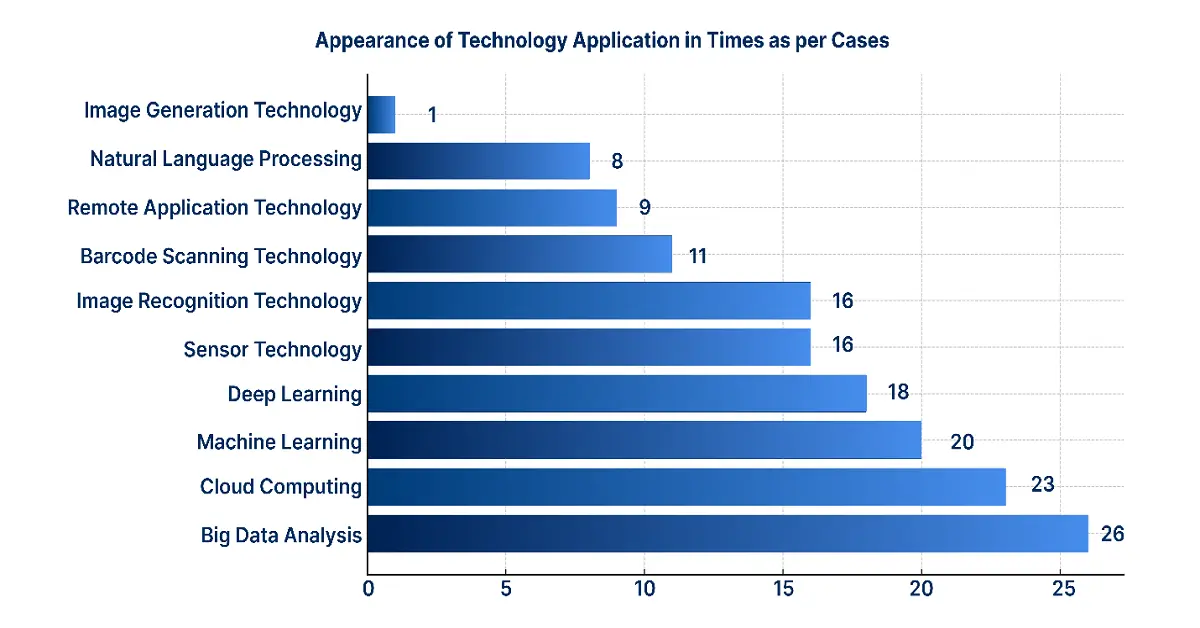Published Date : 26 September 2025
Posted by : Dhruv Bhatia
The retail industry is revolutionizing at a path-breaking speed, and businesses that are unable to keep up with the evolution are experiencing risks and irrelevancy. A seamless storm of economic transitions, fluctuating customer expectations, and technical disruption is readily rewriting commerce rules. At present, shoppers are not only demanding products, but are also craving sustainable, seamless, and customized experiences. Besides, artificial intelligence (AI) is tailoring suggestions with accuracy, while sustainability is transitioning from usefulness to an ultimate purchasing factor. Meanwhile, there is a thin line between offline and online shopping, which is continuing to distort, while social commerce, cashless stores, and augmented reality are gaining increased exposure in sales.
Furthermore, in this evolving environment, retailers are focusing on perishability and innovation. Based on this, the upcoming decade is poised to create a gap between winners and failures, regarding which brands will either lead or stay behind. So, buckle up, as we are breaking down the most ground-breaking retail trends and demonstrating which initiatives will be driving the explosive growth by the end of 2034. The future of shopping exists, so are you ready?
Hyper-Personalization: The AI Shopping Revolution That's Rewriting the Rules of Retail
The period of one-size-fits-all spending has formally ended. In the present ruthless retail scene, AI-driven hyper-personalization has developed as the eventful competitive benefit, and consumers are seeking brands that cater to fierce loyalty. In addition, advanced shoppers are expecting retailers to forecast their requirements with high accuracy, since they are not at all satisfied with general product recommendations. The numbers are totally practical, with almost 75% of customers currently needing brands recognition regarding their purchase and preference history, while retailers are integrating AI-based personalization, with sales reports increasing from 25% to 35%. Besides, for retailers looking for advancements, big data is readily improving shopping experiences. The ultimate key is to tactically partner with service providers to deliver these innovative solutions through collaboration or purchase.
 Source: ScienceDirect
Source: ScienceDirect
This particular revolution is set to expand far beyond just simple suggestions. In this regard, urbane AI is presently analyzing a 360-degree view of every consumer by effectively tracking actual data location, social media activity, past purchases, and browsing patterns to successfully deliver incredible and pertinent experiences. Now, imagine walking in a store, where a phone can guide towards products that either match your style perfectly, or achieve a customized grocery list that caters to dietary supplies and impulsive purchases.
The most upfront-driven retailers are undertaking it further with AI-based chatbots that duplicate dynamic pricing engines and human sales associates, by adjusting in real-time based on shopping behaviors. In this regard, a luxury fashion brand witnessed almost 45% surge in communication after integrating AI that recommended comprehensive outfits based on products remaining in carts. Besides, by the end of 2030, retailers with the absence of strong customization initiatives will be considered irrelevant. Early adopters have already observed 5 times higher consumer lifetime values in comparison to competitors, depending on conventional marketing. Therefore, the message here is clear that in the AI period, customization is not just about having anything nice, but it is like the breakeven factor that separates retail losers from winners.
Moreover, a pro tip regarding this trend is that combining AI with human insight, there are successful integrations by utilizing algorithms to recognize patterns, but also allow the consumer service team to provide that human touch, which effectively develops emotional connections.
Sustainability: The USD 13 Trillion Retail Opportunity You Can't Afford to Ignore
Those days, when sustainability was only a corporate slogan, instead, at present it has emerged as the most dominant and profitability driver in the retail sector. A tectonic transition in customer consciousness has converted eco-friendly strategies from a differentiator to a non-negotiable expectancy, with customers effectively voting based on their respective wallets. For instance, approximately 62% of international consumers are willing to spend higher prices for products that are sustainable, while brands are supporting environment-based responsibility that is growing 3 times rapidly than rivals.
The sustainability evolution is reshaping the retail industry as fashion companies are adopting circular business models, wherein customers replace old garments with receiving discounts on their latest purchases. Besides, grocery chains are integrating blockchain-specific supply chains that permit shoppers to observe a product’s complete carbon journey by scanning QR codes. Likewise, e-commerce players are rotating last-mile delivery into a rational showcase, with carbon-neutral and electric fleets shipping solutions emerging as the standard.
Furthermore, authenticity is something that separates laggards from leaders. Customers have created greenwashing and razor-sharp detectors, avoiding sustainability claims with boycotts, while accepting honest commitment with loyalty. Besides, successful retailers are not only focused on marketing, but executing ESG-based principles into their DNA. For instance, Patagonia’s Don’t Buy This Jacket campaign encouraged accountable consumption, which bolstered sales by 35%, thereby perfectly indicating the paradox.
Therefore, by the end of 2034, retailers with strong ESG strategies are expected to enjoy 20% to 25% of increased profitability in comparison to less sustainable competitors. In addition, they will be benefiting from exclusive pricing power to low consumer acquisition expenses, along with preferred treatment from investors and regulators. Meanwhile, brands that are holding on to ancient models are experiencing existential challenges since sustainability is emerging as the baseline anticipation in comparison to a differentiator.
Phygital Retail: The Seamless Shopping Revolution That's Making Stores Magical Again
The retail catastrophe arena has been successfully reshaped, with brick-and-mortar stores continuously witnessing a high-technology-based renaissance. However, this applies only to smart brands to overcome the gap between digital and physical. In this phygital era, there is an amalgamation of online and in-store components to develop an exquisite shopping experience to effectively reverse the e-commerce aspect. Based on this, an estimated 70% of customers presently require integrated offline and online experiences, while physical stores are adopting amplified reality features, including virtual try-ons, that have experienced 45% high conversion rates. Therefore, this is not just evolution, but an overall reinvention of the shopping experience.
Now, imagine walking into a department store, where a smartphone can be utilized as a personal shopping helper that guides buyers to products, intended to match the purchase history and present wishlist. For instance, picture smart mirrors allow customers to try on nearly 25 outfits within 180 seconds with the absence of entering a trial room. Moreover, QR code-enabled shelves also indicate detailed inventory levels and product stories through a simple scan. For instance, Nike's Reserve & Try program allows consumers to reserve online shoes and physically try them in stores with suitable concierge service. This has eventually bolstered sales by at least 30% while reducing returns.
Furthermore, phygital is an effective approach that constitutes tactile experience and instant gratification of physical retail in combination with information and customization of in-depth e-commerce. For instance, Sephora’s Virtual Artist application, that readily attributes for 15% of increased in-store sales by permitting consumers to evaluate makeup digitally before initiating the purchase, thus proving the model’s power. Likewise, grocery-based stores are steadily getting into action with innovative carts that tend to automate purchases and provide customized coupons while browsing shoppers.
Based on the 2034 outlook, retailers successfully implementing the omnichannel alchemy are expected to capture almost 65% of the overall market share. Therefore, the upcoming future caters to brands that can transform stores into experimental centers, which are driven by digitalized intelligence. This comprised every display, mirror, and shelf, emerging as interactive touchpoints as a part of the continuous shopping journey.
The Autonomous Store Revolution: How Checkout-Free Shopping is Redefining Retail Economics
The retail industry is experiencing its extreme alteration since the development of the shopping cart, as self-sufficient stores are evolving from technology-based demo to mainstream reality. In this regard, Amazon Go’s experimental Just Walk Out technology has blasted into a USD 50 billion market opportunity that fundamentally revised physical retail rules. These cutting-edge stores are leveraging a robust combination that comprises AI-driven analytics, sensor fusion, and computer vision to offer what present customers crave the most, such as queue-free and instantaneous shopping experiences. Based on this, stores integrated an automated checkout report, which ensured 35% rapid transaction times and effective reductions in, while providing the traditional retail service, resulting in satisfied consumers.
But the aspect of revolution is much ahead of consumer convenience. The fundamental business model constitutes an overall reengineering of store economics. By the end of 2034, retailers willing to implement automated technologies are expected to reduce labor expenses by nearly 33%, while also increasing sales density. This results in the ability to cater to increased consumers in the similar physical facility with the absence of checkout bottlenecks. Besides, the majority of players are thinking of the unthinkable, for instance, Walmart’s AI-driven Intelligent Retail Lab has diminished checkout staff by at least 45%, while bolstering consumer throughput. Likewise, 7-Eleven’s cashierless stores have indicated a 21% surge in average basket size, since the non-friction experience has encouraged impulsive purchases.
Moreover, the aspect of technology is increasingly democratizing, and what was needed in millions for infrastructure-based investment can currently be gained through smartphone-powered systems that tend to convert existing stores into autonomous. Startups, such as Trigo and Grabango, readily retrofitted traditional supermarkets with ceiling cameras and shelf sensors at conventional expenses. Based on this, the data is considered to be transformative since these systems can provide real-time insights regarding the shopping and buying behavior, thereby allowing inventory management and hyper-precise merchandising.
Social Commerce: The Trillion-Dollar Shopping Revolution Happening in Your Feed
The existence of a thin line between shopping and social media has formally disappeared. What commenced as usual influencer endorsements has transformed into a USD 1.3 trillion social commerce juggernaut. This eventually converted Pinterest boards, TikTok videos, and Instagram feeds into the digital era’s response to busy shopping districts. For the present generation, the demographic is leading the revolution, with approximately 60% having made their purchases through social platforms directly. This bypassed conventional e-commerce sites, which is not only changing the shopping method but also reshaping the overall retail outlook in real-time.
The aspect of social commerce is considered to be frictionless and a native purchasing experience. Platforms, including Instagram Checkout and TikTok Shop, have diminished the troublesome journey from discovery to purchase by permitting customers to buy that dress without leaving the application. Besides, livestream shopping programs, wherein hosts display products in real-time, are effectively fueling conversion rates 15 times higher than conventional e-commerce, with China-based platforms, such as Douyin, generating USD 250 billion yearly through this format. Meanwhile, Pinterest’s try-on AR technology has contributed to 88% of the overall purchase intent by allowing customers to visualize products in their application before initiating the purchase.
The Future of Retail Profitability
The retail industry in 2034 is projected to be dominated by sustainable brands to ensure transparency in customer needs. This is followed by AI-based retailers to customize products, phygital players to offer both offline and online integration, and automated stores to provide savings for labor expenses and increase profitability. Last, but not least, the presence of social commerce giants to provide direct-to-customer services. Besides, sales growth between 2025 and 2034 is anticipated to be 14% to 17% in the case of AI-based retailers, 12% to 14% for sustainable brands, and 28% for phygital adopters. Therefore, the retail winners of the forecasted year are those who are deliberately acting in the present. Be it social selling, sustainability, or AI, the time to focus on innovation is now.
Contact Us







